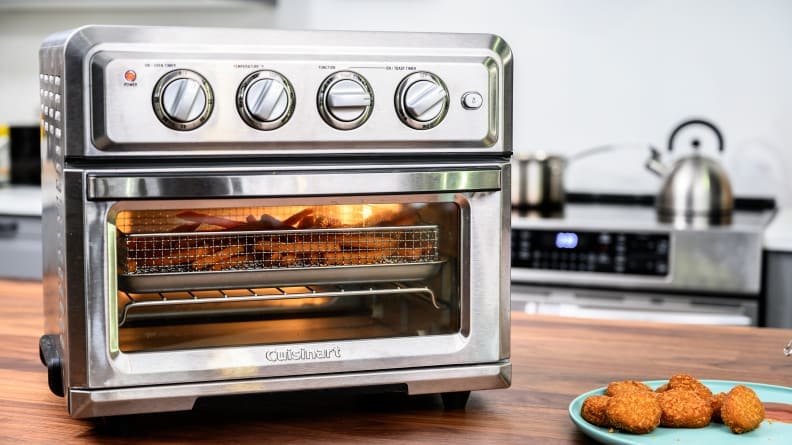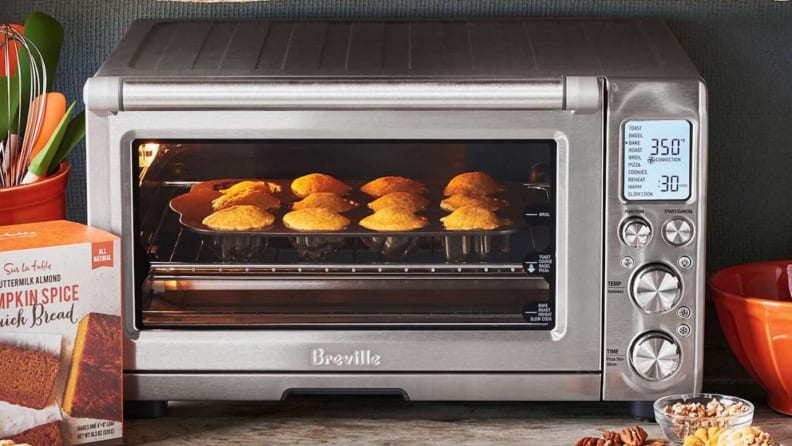 Credit:
Reviewed / Betsey Goldwasser
Credit:
Reviewed / Betsey Goldwasser
Recommendations are independently chosen by Reviewed's editors. Purchases made through the links below may earn us and our publishing partners a commission. Prices were accurate at the time this article was published but may change over time.
The day has finally come—you got an air fryer! All those blogs and recipe books and hack videos about one of the most popular kitchen gadgets of the decade finally apply to you. Crispy veggies, French fries, chicken wings, tofu, and desserts, all with less fat than you'd get from traditional pan or deep frying, are just minutes away.
That is, once you know how to use your new appliance. If you've got an air fryer that also works as a toaster oven, operating should be pretty intuitive—but if you've got an air fryer that's unlike anything you've used before, you probably have some questions.
We've broken down the basics in our roundup of the best air fryers before, so we can help you get started on the road towards air fried perfection.
What is an air fryer?

Some air fryers, like the Breville Smart Oven Air, are also toaster ovens.
Air fryers are essentially compact convection ovens that live on your counter. They cook food by "frying" with very hot air and a small amount of oil, which is incredibly appealing to those of us looking for healthier alternatives to our favorite fried foods or anyone still struggling to master traditional frying techniques.
Since you’re using a limited amount of oil, the end result contains less fat than it would when cooked with conventional pan frying or deep frying methods.
How does an air fryer work?
The convection fan or fans in an air fryer circulate hot air around the foods in the basket, so cooking times will be shorter than with traditional baking. Air fryers can reach high temperatures in a relatively short amount of time, making them a great option for weeknight meals. Plus, because they don’t require the use of large pots of oil, cleanup is usually easier—although cleaning an air fryer is its own process.
Does an air fryer eliminate oil entirely from the cooking process? No, but it does use significantly less than the alternatives. For recipes that do call for oil, you’ll typically be using tablespoons instead of cups to achieve that perfect fry.
What foods can you make in an air fryer?
It depends on how creative you can get! Meats, vegetables, and even baked goods can work in your air fryer.
Some popular air fryer recipes include:
- Vegetables such as potatoes, carrots, squash—essentially anything you would roast on a baking sheet
- Meat dishes, such as breaded chicken, battered chicken, bacon, burgers, and hot dogs
- Frozen foods like chicken nuggets, mozzarella sticks, onion rings, and French fries
- Baked goods such as donuts, fritters, and funnel cake
Tips for using your air fryer

It takes a bit of practice to get great results in an air fryer.
Since air fryers are a relatively new appliance, many models simply aren't up to par in terms of performance. As such, you'll want to be sure you're using a high-quality appliance to get the best results. If you don't yet have an air fryer or want to exchange your new gift, our guide to the best air fryers will help you find a product that will fit your needs and perform well, no matter what you're cooking.
Additionally, here are some tips to keep in mind as you start using your air fryer.
1. Preheat before cooking
Your air fryer needs time to come to temperature before you use it, just like your oven or skillet. Even if your appliance says it doesn't need to preheat, you'll probably get better results if you let it warm up first. Thankfully, it doesn’t take long to preheat an air fryer—typically one to three minutes, as opposed to the eight or more needed when deep frying.
2. Don’t overcrowd!
Just like conventional frying, overloading your air fryer will not produce the best results. Adding too much food to the air fryer may make your meal soggy or unevenly cooked. It may also increase the time needed for your food to fully cook.
3. Flip while frying
You may be frying with air, but you shouldn’t toss out everything you know about frying. You'll still need to bread items properly before dropping them in, and don’t forget to flip your food halfway through.
And don’t feel shy about peeking at your progress during the fry—this will help you get the results you're looking for, especially the first few times you use the appliance.
4. Clean well after use
Don’t skip this step! Food particles can get lodged in the nooks and crannies of your air fryer, building up over time and causing issues down the line. We recommend cleaning your gadget at least partially after each use. Allow the fryer to cool down after you use it, then follow the instructions from the manufacturer (or our air fryer cleaning guide) to clean it properly.





